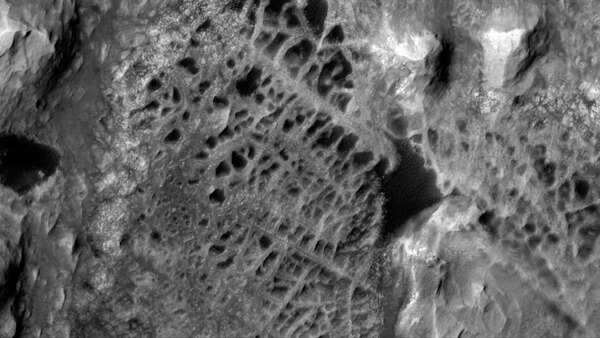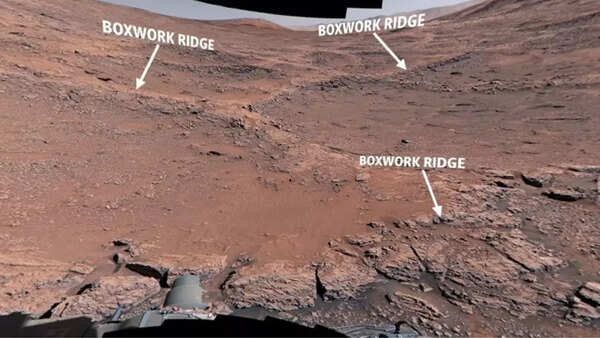NASA's Curiosity rover has made a groundbreaking discovery on the surface of Mars, capturing the first close-up images of peculiar, spiderweb-like rock formations. These unique structures are offering valuable insights into the planet's ancient history and the potential for past life.
The intricate, zig-zagging patterns, scientifically known as "boxwork," were found on the slopes of Mount Sharp within the Gale Crater. Curiosity has been diligently exploring this region since 2012. These mineral-rich ridges are believed to have originated from ancient groundwater activity, creating web-like formations when viewed from above. Scientists are optimistic that these formations may hold crucial clues about Mars' capacity to support microbial life in the distant past.

Despite their intriguing nickname, these "spiderwebs" are not the work of Martian insects. Instead, they are geological formations called boxwork. This pattern arises from the intersection of mineral ridges, formed as groundwater permeates through cracks in the rock and leaves behind mineral deposits. Over eons, wind erosion gradually wears away the surrounding softer rock, exposing the hardened, web-like framework underneath.
While boxwork formations have been previously observed from orbit, this marks the first instance of their detailed examination on the Martian surface. Curiosity reached the site in early June 2025, after a journey of several months across Mount Sharp. NASA unveiled the images, along with an interactive 3D video of the formations, on June 23, emphasizing their unique structure and unexplained location as a high-priority scientific target.

Analysis of the surrounding rocks has revealed the presence of calcium sulfate veins, a salty mineral typically deposited by groundwater. These findings strongly suggest that the area was once abundant in liquid water, potentially creating a warm and salty subterranean environment. Such conditions could have been conducive to microbial life, mirroring environments found on early Earth.
It is crucial to differentiate the newly imaged boxwork formations from the so-called "spiders on Mars." The latter are dark, radial patterns resulting from carbon dioxide ice erupting from beneath the surface. Unlike these seasonal phenomena, boxwork is permanent and mineral-based, shaped by geological processes rather than atmospheric activity.
Scientists hypothesize that these formations may provide crucial evidence to support the theory that Mars once harbored life. The mineral composition, the protection offered by underground conditions, and the evidence of past flowing water collectively suggest an environment that could have sustained microbial organisms. According to Kirsten Siebach, a scientist involved in the Curiosity mission, "Early Earth microbes could have survived in a similar environment."
Curiosity will continue its investigation of the boxwork formations on Mount Sharp, collecting samples and conducting comprehensive chemical analyses. Researchers anticipate that these unique structures will not only shed light on Mars' climate history but also inform future missions in the quest for signs of life beneath the Martian surface.
Newer articles
 Rishabh Pant's Game-Changing Innings Draw Adam Gilchrist Comparisons, Says Greg Chappell
Rishabh Pant's Game-Changing Innings Draw Adam Gilchrist Comparisons, Says Greg Chappell
 Greg Chappell: Rishabh Pant's Explosive Batting Redefining Cricket
Greg Chappell: Rishabh Pant's Explosive Batting Redefining Cricket
 Birmingham Nets Offer Clues: Bumrah's Intent and Kuldeep's Drive Ahead of Second Test
Birmingham Nets Offer Clues: Bumrah's Intent and Kuldeep's Drive Ahead of Second Test
 Gavaskar Calls for Kuldeep Yadav's Inclusion in Second Test Following India's Defeat Against England
Gavaskar Calls for Kuldeep Yadav's Inclusion in Second Test Following India's Defeat Against England
 Bollywood's "Swades" Anthem Joins Axiom-4 Mission, Fueling Indian Astronaut's Space Journey
Bollywood's "Swades" Anthem Joins Axiom-4 Mission, Fueling Indian Astronaut's Space Journey
 Stokes Lauds England's Openers for Setting Up Thrilling Chase Against India
Stokes Lauds England's Openers for Setting Up Thrilling Chase Against India
 Rogue Star Threat: Earth's Solar System Stability at Risk, New Study Warns
Rogue Star Threat: Earth's Solar System Stability at Risk, New Study Warns
 Bangladesh's Shadman Islam Defends Batting Lineup After Day 1 Setbacks Against Sri Lanka
Bangladesh's Shadman Islam Defends Batting Lineup After Day 1 Setbacks Against Sri Lanka
 Mirabai Chanu Reveals Relentless Focus on Training, Weight, and Sacrifices Required for Elite Weightlifting
Mirabai Chanu Reveals Relentless Focus on Training, Weight, and Sacrifices Required for Elite Weightlifting
 India Aims to Rewrite History in Birmingham Test After Headingley Setback
India Aims to Rewrite History in Birmingham Test After Headingley Setback